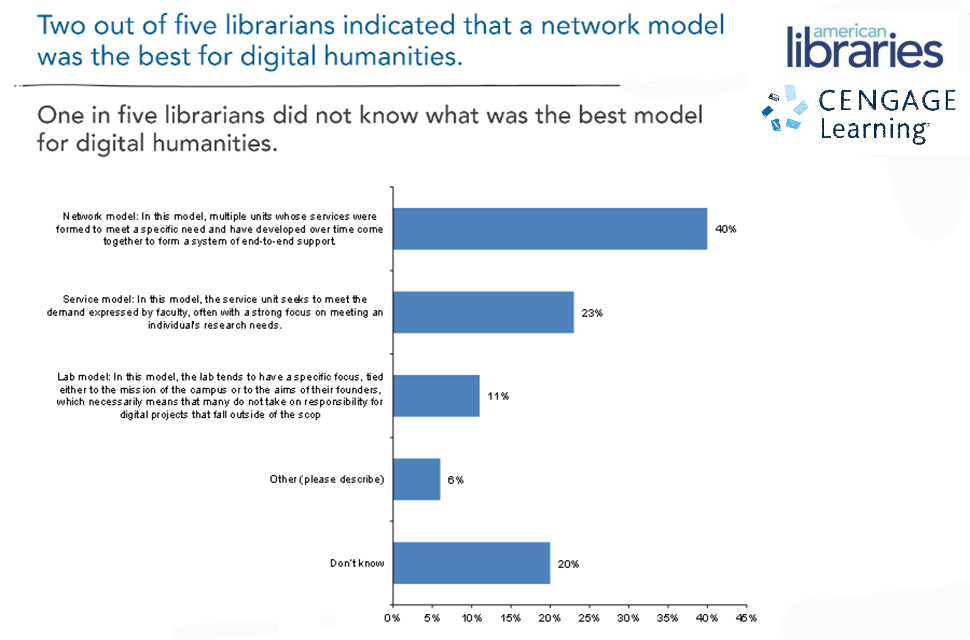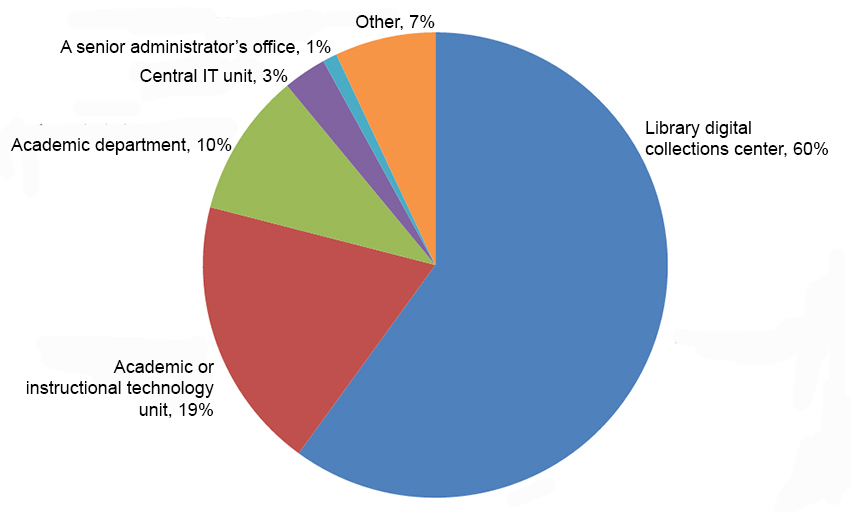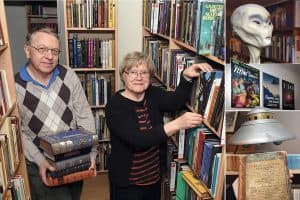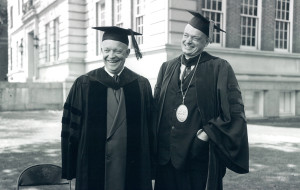
Before the internet, humanities scholars conducted research traditionally, by examining historical documents, original artworks, and first editions of literary texts in the special collections reading rooms of university libraries. But as more of these tools became available to the academic community through online databases, faculty recalibrated their research techniques and librarians adjusted the way they teach research methodologies to students.
The sea change brought about by digital humanities (DH) resources is still rippling through academia. As Stewart Varner and Patricia Hswe write in their special report on “Digital Humanities in Libraries” (American Libraries, Jan./Feb. 2016), libraries are “unsure how they should respond as DH attracts more and more practitioners and its definition evolves to cover an ever-expanding range of techniques and methods.”
In 2015, American Libraries and Gale, part of Cengage Learning, partnered in a survey of academic librarians and faculty to assess the current and future roles of libraries in providing and supporting DH materials on campus. The survey was conducted via email between October 2 and December 17, 2015, with American Libraries inviting academic librarians and Gale inviting faculty members in specific disciplines to participate.
A team of researchers—led by Gale’s Director of New Product Strategy and Development Bret Costain and Cengage Learning Senior Research Statistician Phillip Elliott, and joined by Kathy Rosa, director of the American Library Association’s Office for Research and Statistics—created the survey questions and analyzed the results. A total of 339 librarians and 409 humanities faculty completed the questionnaires, giving a margin of error of ±5.3% and ±4.8% respectively.
At the 2016 ALA Midwinter Meeting in Boston, Rosa gave a presentation on the preliminary findings, saying that “Faculty and librarians are so important in this process of defining and making real the digital humanities that it’s going to affect all of us.” She added, “What I’ve been thinking about is how this will affect the students. They are the ones who will inherit this and carry the field further. By focusing on student needs, libraries can position themselves as central to the process and justify the additional staff and resources they will require.”
Gale Vice President Ray Abruzzi told American Libraries that he thought librarians have an opportunity to “raise their profile on campus with scholars, with students, and with the administration as a whole” by taking on a leadership role as “active collaborators and participants in the research process.” He added that Gale’s next step will be to hold a forum to bring “faculty and librarians together around DH, both those with success stories as well as those who are just now getting on to this track.”
Varner and Hswe reviewed some of the responses in their American Libraries article, but the full results are now online for both librarians and faculty. Here are a few key findings.
Librarian responses
The majority of librarians prefer a collaborative relationship with faculty. Seven out of 10 librarians indicated that the acquisition, transcription, and coding of digital source materials should be shared by librarians and humanities faculty. Only 20% felt that this should be the sole province of the library, and 11% thought that humanities faculty should be doing it. Some 63% of librarians see themselves as full-fledged project collaborators and participants in providing DH services.
The role that the library plays in DH research is still evolving. Four out of 10 librarians said that their DH services are “ad hoc.” Another 17% said they provided no services to users engaged in DH projects, although an equal number wrote that their library has a digital scholarship center that assists multiple disciplines. The most common methods of support were:
- institutional repositories (54%)
- digital preservation (50%)
- improving access to metadata (46%)
- campus-wide DH coordination (43%)
- consulting with faculty on digitization projects (37%)
- project sustainability planning (33%)
In most cases, a subject librarian or digital scholarship librarian provides support for DH projects (45%).
Funding for DH is spread across institutional departments. Although 58% reported that the library operating budget was the source of funding for DH projects, other revenue sources included:
- grants (47%)
- academic departments (35%)
- one-time funds (27%)
- the library IT budget (17%)
A majority (88%) of librarians indicated their libraries do not have a written statement describing DH support, nor is there a formal process for reviewing DH project proposals (81%).
Librarians rate institutional support for DH projects as generally low. Only 23% rated their library’s effectiveness at seven points or higher on a 10-point scale. The most common challenges to effectiveness were:
- difficulty connecting with faculty (26%)
- lack of institutional commitment (24%)
- lack of authority to marshal resources (13%)
- inflexible IT structure (9%)
Staffing is a serious hindrance to effective DH services, with 41% indicating that additional hires with special technical skills and knowledge were needed. Open-ended responses included:
- “A digital resource center would [ideally] have a professional director, one instructional designer, a part-time support staff person for logistics, and a team of student workers. Also some dedicated space, equipment, and a recurring budget.”
- “A digital humanities librarian would need technology expertise, an understanding of the changing role of the humanities in our 21st-century culture, the ability to pool resources and create collaborations to avoid duplication of effort, and the ability to communicate the significance of the humanities and their role in libraries of the future.”
- “Computers, software, network infrastructure are all important, but there needs to be a willingness to engage students and faculty in digital scholarship, even when there are knowledge gaps.”
Faculty responses
From a faculty perspective, support for DH projects enhances the status of academic libraries. Some 60% of the faculty felt that a DH center belongs in the library’s digital collections, and 90% thought that DH support elevates a library’s importance:
- “Digital is the new form of research, replacing microfilm and paper—or complementing them, at least.”
- “Digital humanities support can help faculty see libraries as not just repositories of information but also as partners in academic pursuits.”
- “Librarians have better and broader training in this regard than most faculty, and they know how to address creation, curation, and student learning goals and outcomes for information fluency.”
Most of the faculty surveyed use DH resources, and many of them use personal funds for research. Roughly 88% use digital tools in their research or teaching, including web resources, databases, subject-specific software, e-journals and ebooks, and statistical apps. More than half (54%) have used their own money for research. Internal (40%) and external grants (30%) sometimes came into play, but only a small percentage receive funding from sponsorship (8%), a central IT budget (8%) or donations (5%). About three-quarters of the faculty share their digital research in some way:
- classroom teaching (77%)
- conference presentations (74%)
- academic journal articles (57%)
- books (40%)
- popular journal articles or blog posts (33%)
- social media discussions (27%)
A majority (79%) require their students to use DH resources, although only 57% felt the library is equipped to provide the proper assistance.
Many faculty recognize that libraries could provide them with additional services and resources. Some 55% would like the library to offer digital content management services. Other desired services included:
- initial project development consultations (54%)
- grant writing to support DH research (46%)
- outreach and marketing (32%)
The most common resources that faculty want the library to provide are collections of primary source content. Other faculty wishes were:
- secondary source digital content, such as e-journals (67%)
- digital tools or software (49%)
- data produced using computational methods (35%)
- digital platforms, such as a wiki (31%)
Perhaps the survey findings are best summed up in two open-ended comments by a faculty member and a librarian.
Faculty member: “‘Library’ is now an inadequate term. The new term should be ‘Academic Resource Center,’ a place that should position itself at the center of the new learning protocols. No discipline is untouched by digital involvement, and colleges need to market these centers as places where students can learn actively.”
Librarian: “The primary need (other than more money and staff, which are always in short supply) is a more open attitude among staff and administration toward new roles for the library, a willingness among library staff to learn new skills or hire people who have them, and support from our library admin to allow us time to develop new roles. Of course, we also need researchers with the same attitudes who will ask us to collaborate with them on multiple projects.”



